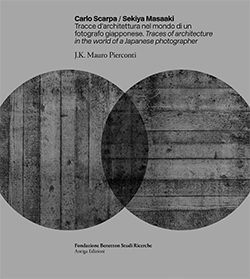
Carlo Scarpa / Sekiya Masaaki
Tracce d’architettura nel mondo di un fotografo giapponese. Traces of architecture in the world of a Japanese photographer
by J.K. Mauro Pierconti
Fondazione Benetton Studi Ricerche-Antiga Edizioni
Treviso 2023
224 pages, 329 illustrations
cover price 30 euro, ISBN 978-88-8435-375-7
bilingual edition, in Italian and English
Carlo Scarpa (1906-1978) and Sekiya Masaaki (1942-2002): the work of the Italian architect emerges from and merges with the multi-faceted world of the Japanese photographer, which of course centred on architecture but embraced many other interests, including the promotion of talented photographers such as Hattori Aiko, a selection of whose wide-ranging reportage of Tōkyō in the 1980s appears in the book with an introductory text.
The book also includes sections dedicated to Sekiya’s photographic campaigns at Angkor, in Cambodia, revealing the ancient Khmer city, now in ruins and nigh on overwhelmed by nature; in Vienna, with the buildings of Otto Wagner; and above all in Italy, where Sekiya’s death curtailed his last major enterprise, coverage of the work of Carlo Scarpa, a generous selection of which is presented here for the first time.
Sekiya’s photographs prompt a series of texts, which explore some of the themes Scarpa pursued in his architecture, especially as regards the centrally important Brion Tomb complex.
Archival research has brought to light not only the photographs Sekiya took over the years but also preparatory material, proofs and corrections, prints and drawings that reveal new and far-reaching links between the Japanese photographer and the Scarpa family, including his involvement in plans (unfortunately they never left the drawing-board) that Afra and Tobia Scarpa produced for a house for the industrialist Hisaeda Shōichi between the end of the 1980s and the beginning of the ’90s.
The Hisaeda and Sekiya archives have yielded original material relating to that project, which developed ideas that Afra and Tobia explored in previous ventures, from their house in Trevignano to the Molteni House, with Tobia’s passion for creating a tea room with Japanese craftsmen.
Multiple connections thus link the life and work of Carlo and Tobia Scarpa with those of Sekiya, the photographer from the Far East.
The book, a Fondazione Benetton Studi Ricerche-Antiga co-publcation, accompanies and expands the contents of the exhibition of the same name organised by the Fondazione Benetton Studi Ricerche at its Ca’ Scarpa venue in Treviso, from 15th April to 16th July 2023.
Contents
Preface
by Luigi Latini
When Masaaki arrived
by Tobia Scarpa
At the service of the work of Carlo Scarpa
I. The Brion Family Tomb by Carlo Scarpa: the ‘funereal garden’ and the female form
II. The Brion Family Tomb in the photographs of Sekiya Masaaki
Appendixes
1. On the tomb of the Brions
2. On painting, and on the work of Marcel Duchamp in particular
III. Photographs for Carlo Scarpa
La Tomba Brion, San Vito d’Altivole
Negozio Olivetti, Venice
Museo Castelvecchio di Verona
Fondazione Querini Stampalia, Venice
Monumento alla Partigiana di Augusto Murer, Venice
Villa Palazzetto, Monselice
Banca Popolare di Verona
Villa Ottolenghi, Bardolino
IV. Links and interlinks: Carlo, Tobia and Sekiya
Sekiya Archive – Carlo Scarpa projects
V. Sekiya as a photographic producer in Tōkyō: the case of Hattori Aiko and street photography
VI. Sekiya Masaaki. Angkor Wat and Otto Wagner’s Vienna
Bibliography
Ca’ Scarpa takes wing
J.K. Mauro Pierconti is an architectural historian who trained at the Iuav University in Venice. After teaching at Venice International University, he was awarded post-graduate scholarships by the Japan Foundation and the Japan Society and for several years pursued his research interests at Tōkyō University and Waseda University. He is currently the curator in charge of Ca’ Scarpa in Treviso for the Fondazione Benetton Studi Ricerche. He has published widely on Carlo Scarpa and Japanese architecture and has also worked on the creation of documentaries and exhibitions.
